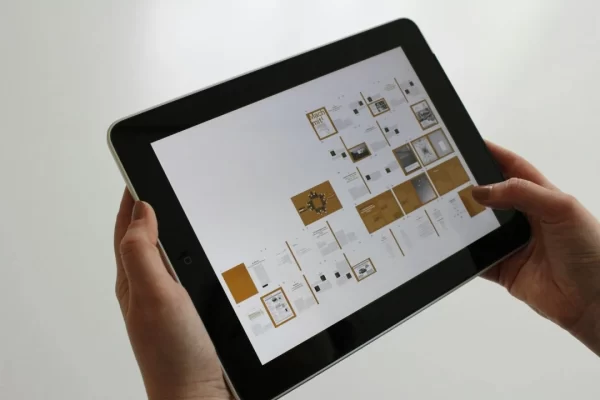In today’s digital marketplace, achieving business success transcends mere statistics. Here at Digital Rescue, we recognise that an outstanding user experience (UX) design is the cornerstone of this success. It embodies the vital essence that safeguards intellectual assets and fosters enduring customer bonds as your enterprise expands and adapts.
Throughout this discussion, we will delve into the pivotal role of UX design across four fundamental domains: Interaction Design, Information Architecture, Visual Design, and User Research. Furthermore, we will elucidate how businesses can harness these facets of UX design to elevate their online platforms, enrich customer interaction, and cultivate sustainable advancement.
The Four Essential UX Design Types You Need to Know
Interaction Design
Interaction design is at the core of every outstanding user experience; a discipline focused on shaping how users engage with a product or system. This principle transcends mere aesthetics, delving into a user interface’s seamless functionality and intuitive flow (UI).
Through a deep understanding of users’ needs, behaviours, and motivations, interaction designers craft interfaces within their web designs that streamline interactions and empower users to accomplish their objectives efficiently.
In digital marketing, businesses must recognise the significance of robust interaction design skills. Enterprises with proficient interaction design capabilities tend to offer products that deeply connect with users, resulting in heightened customer satisfaction and improved retention rates. When seamlessly woven into a digital marketing strategy, effective interaction design undoubtedly elevates the overall usability of a company’s website or application.
Visual Design
Visual design within UX design holds a substantial influence in moulding brand identity and eliciting emotions from users. It offers valuable insights into brand coherence and emotional connections with customers and in our perspective, stands as an area deserving deeper recognition as a tool for enhancing user experience.
Visual design transcends mere aesthetics. It involves tactically employing colours, typography, icons, and various graphical elements to achieve business objectives:
- Evoke user emotions
- Strengthen brand recognition
- Communicate a consistent message
- Establish trust and authority throughout the company’s evolution
Moreover, visual design is a powerful instrument for crafting a differentiation strategy. A visually unique brand can captivate attention and leave a lasting imprint on users.
Incorporating robust visual design principles into a website guarantees the company’s products, visuals, and marketing materials harmonise with its brand strategy. This harmonious alignment cultivates a seamless visual journey, reinforcing brand allegiance and nurturing favourable connections with the company’s offerings.
Information Architecture
Information Architecture (IA) serves as the foundational plan for arranging and structuring information, guaranteeing effortless accessibility and comprehension for users. Within digital marketing, assessing a team’s IA proficiency unveils its adeptness in managing intricate website frameworks and user pathways.
Integrating robust IA methodologies into the development process can optimise workflow efficiency and content management. This facilitates smooth navigation and seamless information exploration across the digital platform. Thoughtfully structured IA systems empower users to swiftly locate and access information, enriching their experience and mitigating frustration.
Moreover, it’s essential to emphasise that companies striving to expand their digital footprint require a meticulously crafted IA system. IA possesses scalability, capable of accommodating supplementary content, products, or services as the business progresses.
This adaptability guarantees that the IA framework remains resilient despite evolving business requirements without sacrificing usability—an additional crucial facet of advancing a user-centric approach that nurtures customer engagement and retention.
User Research
User Research is the cornerstone of UX design, diving deep into user needs, behaviours, and pain points. It is an indispensable asset for any business, particularly those navigating the digital landscape, striving to refine their user experience and forge a customer-centric strategy.
Through User Research, businesses unearth potential market opportunities and unexplored customer segments. Through comprehensive interviews, surveys, and market analysis, UX researchers pinpoint gaps in the market and opportunities for the company to address unmet user needs.
Leveraging insights from user research empowers firms to uncover fresh opportunities across multiple domains. Whether evaluating product alignment, confirming marketing hypotheses, or integrating user-centric methodologies, such research avenues are commonplace.
Through a comprehensive understanding of user needs, validation of assumptions, and ongoing refinement of products and services, UX researchers significantly contribute to the business’s prosperity and expansion. Embracing user research as an integral element of M&A strategies enhances stakeholder value and elevates customer satisfaction levels, securing a competitive advantage in the market.
Emerging Technologies Shaping UX Design
In the ever-changing field of user experience (UX) design, staying current on emerging technologies is critical. From artificial intelligence (AI) to augmented reality (AR), innovative technologies are reshaping how designers conceptualise and create user interfaces. Let’s look into the impact of these emerging technologies on UX design.
Artificial Intelligence (AI) in UX Design
AI has revolutionised UX design by enabling personalised and predictive user experiences. Subheadings under this section could include:
- Intelligent Chatbots: AI-powered chatbots enhance customer support by providing real-time assistance and personalised recommendations.
- Predictive Analytics: Leveraging AI algorithms, designers can anticipate user behaviour and tailor interfaces to meet individual preferences.
- Voice User Interfaces (VUIs): Voice-activated interfaces offer hands-free interaction, simplifying tasks and improving accessibility.
Virtual Reality (VR) and Augmented Reality (AR) Experiences
VR and AR technologies transform UX design by immersing users in virtual environments and overlaying digital content onto the physical world. Subheadings may include:
- Immersive User Interfaces: VR interfaces create immersive experiences, allowing users to interact with digital content in three-dimensional spaces.
- AR Enhancements: AR overlays digital information onto the real world, enriching user interactions with contextual information and interactive elements.
- Spatial Computing: Spatial computing merges VR and AR technologies, enabling intuitive interactions within physical spaces, such as gesture-based controls and spatial mapping.
Internet of Things (IoT) Integration
The proliferation of IoT devices has expanded the scope of UX design beyond traditional screens, encompassing connected devices and smart environments. Subheadings could cover:
- Seamless Device Integration: UX designers must ensure seamless integration between IoT devices and user interfaces, providing cohesive user experiences across multiple touchpoints.
- Contextual Awareness: IoT sensors collect data on user behaviour and environmental factors, enabling designers to deliver contextually relevant experiences tailored to specific contexts.
- Voice and Gesture Controls: With IoT-enabled devices, users can interact via voice commands or gestures, offering intuitive and hands-free control options.
Design Ethics and Responsible Innovation
Designers must prioritise ethical considerations and responsible innovation as technology advances to safeguard user privacy and promote inclusivity. Subheadings may include:
- Ethical Design Principles: Designers should adhere to ethical guidelines and principles to ensure user trust and mitigate potential harm.
- Inclusive Design Practices: Incorporating inclusive design practices ensures that products are accessible to users of all abilities and demographics.
- Data Privacy and Security: Upholding data privacy and security measures is essential to protect user information and maintain trust in digital products.
The rapid advancement of emerging technologies presents both opportunities and challenges for UX designers. By embracing these technologies thoughtfully and responsibly, designers can create immersive, personalised, and inclusive experiences that enhance user satisfaction and drive business success in the digital age.
Challenges and Opportunities in the Evolving Landscape of UX Design
With emerging technologies, shifting user expectations, and ever-changing market dynamics, UX designers face a myriad of challenges and opportunities. Let’s explore some of the key challenges and opportunities shaping the evolving landscape of UX design.
Challenges in the Landscape of UX Design
- Cross-Platform Consistency – As users engage with multiple devices and platforms, maintaining consistency across all touchpoints poses a significant challenge for UX designers.
- Personalisation at Scale – With the demand for personalised experiences on the rise, delivering tailored content and interactions at scale presents a formidable challenge for UX designers.
- Accessibility and Inclusivity – Ensuring accessibility and inclusivity for users of all abilities and backgrounds remains a persistent challenge in UX design.
- Designing for Emerging Technologies – UX designers face unique challenges when designing intuitive and user-friendly interfaces for emerging technologies like virtual reality (VR), augmented reality (AR), and voice assistants.
- Balancing Innovation with Usability – Striking the right balance between innovation and usability is a perpetual challenge for UX designers, particularly when introducing new features or design elements.
Opportunities in the Landscape of UX Design
- Unified User Experiences – Designers can seize the opportunity to create unified user experiences by leveraging design systems and responsive design principles, ensuring seamless transitions between different platforms and devices.
- AI-Powered Personalisation – AI technologies offer opportunities for automated personalisation, enabling designers to analyse user data and deliver personalised experiences at scale through recommendation engines and predictive analytics.
- Inclusive Design Practices – By incorporating inclusive design practices, such as accessible colour contrasts, keyboard navigation, and screen reader compatibility, designers can create products that are usable by a diverse range of users.
- Immersive Experiences – Embracing emerging technologies opens up opportunities for designers to create immersive experiences that push the boundaries of traditional UX design, offering users new ways to interact with digital content and services.
- Iterative Design Processes – Adopting iterative design processes, such as user testing and feedback loops, allows designers to innovate while focusing on usability, ensuring that new features meet user needs and expectations.
Embracing these challenges as opportunities for learning and adaptation, UX designers can navigate the evolving landscape with confidence and creativity.
Learn How UX Design Impacts Your Business Growth Today!
Crafting a flourishing business is akin to orchestrating a symphony of art and science, where customer satisfaction fuels growth. As digital transformation unfolds, the adept guidance of a skilled web design agency is paramount. At Digital Rescue, we offer expertise, processes, and strategies to fortify your digital presence seamlessly, ensuring uninterrupted growth. Don’t stall your progress with unforeseen hurdles. Book a free chemistry call now!



